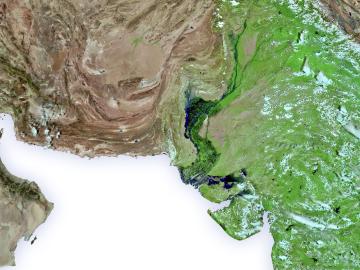
Filter News
Area of Research
- (-) Biology and Environment (177)
- (-) Fusion and Fission (54)
- (-) Neutron Science (190)
- (-) Supercomputing (311)
- Advanced Manufacturing (34)
- Biological Systems (18)
- Biology and Soft Matter (5)
- Building Technologies (12)
- Chemical and Engineering Materials (4)
- Chemistry and Physics at Interfaces (11)
- Clean Energy (522)
- Climate and Environmental Systems (14)
- Computational Biology (6)
- Computational Chemistry (5)
- Computational Engineering (5)
- Computer Science (19)
- Data (1)
- Earth Sciences (1)
- Electricity and Smart Grid (3)
- Energy Frontier Research Centers (14)
- Energy Sciences (5)
- Fossil Energy (3)
- Fuel Cycle Science and Technology (3)
- Functional Materials for Energy (16)
- Fusion Energy (17)
- Geographic Information Science and Technology (3)
- Isotope Development and Production (3)
- Isotopes (35)
- Materials (433)
- Materials Characterization (2)
- Materials for Computing (36)
- Materials Synthesis from Atoms to Systems (13)
- Materials Under Extremes (12)
- Mathematics (1)
- National Security (80)
- Neutron Data Analysis and Visualization (4)
- Nuclear Science and Technology (74)
- Nuclear Systems Modeling, Simulation and Validation (3)
- Nuclear Systems Technology (1)
- Quantum Condensed Matter (4)
- Quantum information Science (9)
- Reactor Technology (1)
- Renewable Energy (4)
- Sensors and Controls (5)
- Transportation Systems (11)
News Type
News Topics
- 3-D Printing/Advanced Manufacturing (19)
- Advanced Reactors (9)
- Artificial Intelligence (43)
- Big Data (26)
- Bioenergy (53)
- Biology (76)
- Biomedical (37)
- Biotechnology (14)
- Buildings (7)
- Chemical Sciences (19)
- Clean Water (13)
- Climate Change (51)
- Composites (6)
- Computer Science (107)
- Coronavirus (24)
- Critical Materials (5)
- Cybersecurity (9)
- Decarbonization (26)
- Energy Storage (20)
- Environment (110)
- Exascale Computing (25)
- Fossil Energy (2)
- Frontier (30)
- Fusion (23)
- Grid (9)
- High-Performance Computing (53)
- Hydropower (8)
- Isotopes (3)
- ITER (6)
- Machine Learning (20)
- Materials (36)
- Materials Science (39)
- Mathematics (3)
- Mercury (7)
- Microscopy (18)
- Molten Salt (1)
- Nanotechnology (25)
- National Security (9)
- Net Zero (4)
- Neutron Science (101)
- Nuclear Energy (34)
- Partnerships (8)
- Physics (18)
- Polymers (5)
- Quantum Computing (19)
- Quantum Science (29)
- Renewable Energy (1)
- Security (6)
- Simulation (26)
- Software (1)
- Space Exploration (5)
- Summit (46)
- Sustainable Energy (39)
- Transformational Challenge Reactor (1)
- Transportation (14)
Media Contacts

The Department of Energy’s Oak Ridge National Laboratory hosted the second 2023 cohort of the International Atomic Energy Agency’s Lise Meitner Programme in October.

Using neutrons to see the additive manufacturing process at the atomic level, scientists have shown that they can measure strain in a material as it evolves and track how atoms move in response to stress.

A new study by researchers at the Department of Energy’s Oak Ridge National Laboratory looks at some of the influences that could be driving the increasingly severe weather over Pakistan.

ORNL will lead three new DOE-funded projects designed to bring fusion energy to the grid on a rapid timescale.
To better understand important dynamics at play in flood-prone coastal areas, Oak Ridge National Laboratory scientists working on simulations of Earth’s carbon and nutrient cycles paid a visit to experimentalists gathering data in a Texas wetland.

As current courses through a battery, its materials erode over time. Mechanical influences such as stress and strain affect this trajectory, although their impacts on battery efficacy and longevity are not fully understood.

ORNL’s Fulvia Pilat and Karren More recently participated in the inaugural 2023 Nanotechnology Infrastructure Leaders Summit and Workshop at the White House.

In 1993 as data managers at ORNL began compiling observations from field experiments for the National Aeronautics and Space Administration, the information fit on compact discs and was mailed to users along with printed manuals.

The Department of Energy’s Oak Ridge National Laboratory announced the establishment of the Center for AI Security Research, or CAISER, to address threats already present as governments and industries around the world adopt artificial intelligence and take advantage of the benefits it promises in data processing, operational efficiencies and decision-making.

For 25 years, scientists at Oak Ridge National Laboratory have used their broad expertise in human health risk assessment, ecology, radiation protection, toxicology and information management to develop widely used tools and data for the U.S. Environmental Protection Agency as part of the agency’s Superfund program.


